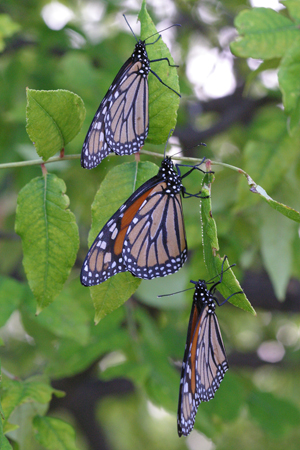Don’t misunderstand me. I like honey bees. And like most people I talk with, I’m aware of the threat to honey bees posed by the latest calamity facing beekeepers, the “colony collapse disorder”. Managed bee colonies in our country and around the world are dying off at alarming rates. And this is not good.
But honey bees are not native to the New World. If all the honey bees in the U.S. were to die tomorrow, agriculture would take a devastating hit, and we would see an immediate impact on food prices and grocery store offerings. But the loss of honey bees would likely leave our natural ecosystems mostly unaffected.
On the other hand, consider the plight of the eastern monarch butterfly. According to a recent study published in the journal Insect Conservation and Diversity the overwintering population of eastern monarch butterflies reached an all-time low in 2009-2010. This followed a 15 year trend of decline in monarch abundance, since records were established in 1994-1995.
The authors of the monarch study point to several reasons for the decline: (1) loss of critical overwintering habitat in Mexico through extensive illegal logging; (2) widespread reduction in the monarch’s principal food plant in the U.S., common milkweed, Asclepias syriaca, by herbicides and habitat modification; and the recent extreme weather conditions affecting both overwintering sites and in the southern U.S.
I would argue that we should be just as concerned, or more concerned, about this American native as we are about the honey bee. The same forces affecting monarchs are affecting wildlife throughout our country and the world. Monarchs are only unique because they are commonly observed, distinctive and, let’s face it, pretty. Who can’t appreciate the beauty of a monarch butterfly? Add to its beauty, the fact that the Eastern monarch is one of a handful of true migratory insects in our country, with some of the brood each year traveling thousands of miles from nursery to overwintering sites in the mountains of Central America.
Maybe it’s this reason that monarchs are the state insect or butterfly for at least seven states, including Texas. I know I look forward each year to the annual monarch migrations that signal the beginning of spring (as the monarchs fly north) and fall (when the butterflies pass through Texas on their way to Mexico). It would be sad beyond words to lose this wonderful creature.
If you care about monarch butterflies (and other arthropods) check out the Monarch Watch website, consider planting more native plants (including milkweed) in your own backyard, and care about the wild places near your home.
We can always import more honey bees, but if we lose the monarch there is no getting it back.

